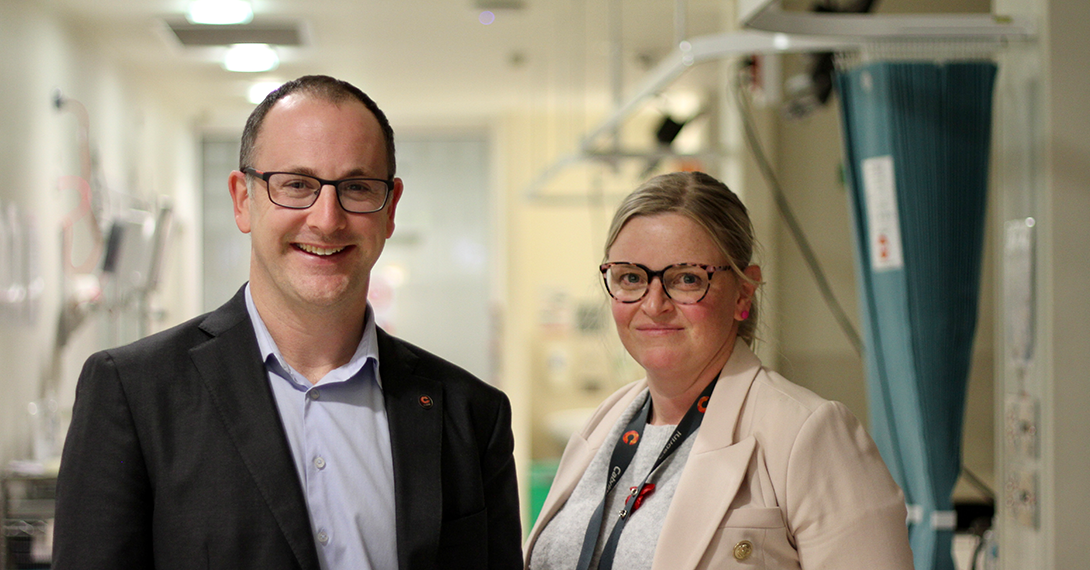About the urology research department
Prostate cancer is the most commonly diagnosed cancer in Australian men. More than 60 men die each week from prostate cancer. Our research is helping to change those outcomes.
Through clinical translational research, laboratory based discovery, and clinical trials, we are improving the diagnosis, treatment, management, and prevention of prostate cancer.
With a research effort spanning across Cabrini and Monash University, our team focuses on understanding the biology of prostate cancer, discovering why patients respond differently to treatments, identifying how to effectively use imaging to detect and stage prostate cancer, and developing accurate disease progression risk stratification models.
Our research will help improve treatments and enable clinicians to design individualised treatment and disease management plans, saving patients from unnecessary treatments and procedures and ensuring those who really need it are fast tracked onto treatment protocols.
Team members
Collaborations
Professor Gail Risbridger and Associate Professor Renea Taylor, joint leaders of the Prostate Cancer Research Group Lab at Monash University
The collaboration has led to the development of patient prostate cancer derived xenografts in the laboratory from all different stages of the prostate cancer journey.
- Xenograft models are developed by taking tumour tissue from prostate cancer patients during surgery and then implanting them under the skin of laboratory mice genetically bred to not reject human tissue.
- Xenograft models allow in vivo testing and have enormous utility as a platform to test new drugs and therapeutics so that patients can obtain the very best treatment for their stage of disease.
- Our xenograft models are being increasingly used by pharmaceutical companies to test new therapeutics in prostate cancer.
- Bensley JG, Dhillon HM, Evans SM, Evans M, Bolton D, Davis ID, Dodds L, Frydenberg M, Kearns P, Lawrentschuk M, Murphy DG, Millar JL, Papa N (2021). Self-reported lack of energy or feeling depressed 12 months after treatment in men diagnosed with prostate cancer within a population-based registry. Psycho-Oncology. doi: 10.1002/pon/5833.
- Bowden P, See AW, So K, Lawrentschuk N, Moon D, Murphy DG, Rao R, Crosthwaite A, King D, Haxhimolla H, Grummet J, Ruljancich P, Gyomber D, Landau A, Campbell N, Frydenberg M, Smyth LML, Nolan S, Gwini SM, McKenzie DP. (2021). 68 Ga-PSMA-PET screening and transponder-guided salvage radiotherapy to the prostate bed alone for biochemical recurrence following prostatectomy: interim outcomes of a phase II trial. World J Urol. doi: 10.1007/s00345-021-03735-0
- Bruinsma SM, Nieboer D, Roobol MJ, Bangma CH, Verbeek JFM, Gnanapragasam V, Van Hemelrijck M, Frydenberg M, Lee LS, Valdagni R, Logothetis C, Steyerberg EW. (2021) Risk-Based Selection for Active Surveillance: Results of the Movember Foundation’s Global Action Plan Prostate Cancer Active Surveillance (GAP3) Initiative. J Urol. 206(1):62-68. doi: 10.1097/JU.0000000000001700
- Choo N, Ramm S, Luu J, Winter JM, Selth LA, Deyer AR, MURAL Investigators, Frydenberg M, Grummet J, Sandhu S, Hickey TE, Tilley WD, Taylor RA, Risbridger GP, Lawrence MG, Simpson KJ. (2021) High-throughput imaging assay for drug screening of 3D prostate cancer organoids. SLAS Discovery (SABI2 Special Issue). doi: 10.1177/24725552211020668
- Chow K, Bedo J, Ryan A, Agarwal D, Bolton D, Chan Y, Dundee P, Frydenberg M, Furrer MA, Goad J, Gyomber D, Hanegbi U, Harewood L, King D, Lamb AD, Lawrentschuk N, Liodakis P, Moon D, Murphy DG, Peters JS, Ruljancich P, Verrill CL, Webb D, Wong L-M, Zargar H, Costello AJ, Tapenfuss AT, Hovens CM, Corcoran NM. (2021) Ductal Variant Prostate Carcinoma is Associated with a Significantly Shorter Metastasis Free Survival. European Journal of Cancer. 148:440-450. doi:10.1016/j.ejca.2020.12.030.
- de Feria Cardet RE, Hofman MS, Segard T, Yim J, Williams S, Francis RJ, Frydenberg M, Lawrentschuk N, Murphy DG, De Abreu Lourenco R. (2021) Is Prostate-specific Membrane Antigen Positron Emission Tomography/Computed Tomography Imaging Cost-effective in Prostate Cancer: An Analysis Informed by the proPSMA Trial. European Urology. 79(3):431-418. doi: 10.1016/j.eururo.2020.11.043
- Frydenberg M (2020). Long-term risks of metastases in men on active surveillance for early-stage prostate cancer. Practice Update. (Commentary). Link: https://www.practiceupdate.com/content/long-term-risks-of-metastases-in-men-on-activesurveillance-for-early-stage-prostate-cancer/109943/65/3/1
- Frydenberg M (2021). A Phase 2/3 Prospective Multicenter Study of the Diagnostic Accuracy of Prostate Specific Membrane Antigen PET/CT With 18F-DCFPyL in Prostate Cancer Patients (OSPREY). PracticeUpdate website. Commentary. Link: https://www.practiceupdate.com/content/diagnostic-accuracy-of-prostate-specific-membrane-antigen-18f-dcfpyl-petct-in-prostate-cancer-patients/119929/65/3/1.
- Hayne D, Grummet J, Espinoza D, McCombie SP, Chalasani V, Ford K, Frydenberg M, Gilling P, Gordon B, Hawks C, Konstantatos A, Martin AJ, Nixon A, O’Brien C, Patel MI, Sengupta S, Shahbaz S, Subramaniam S, Williams S, Woo H, Stockler MR, Davis ID, Buchan N. (2020) Pain-free TRUS B: A phase 3 double-blind placebo-controlled randomized trial of methoxyflurane with periprostatic local anaesthesia to reduce the discomfort of transrectal ultrasound-guided prostate biopsy (ANZUP 1501). BJU Int. doi: 10.1111/bju.15552
- Kalapara AA, Ballock ZE, Ramdave S, O’Sullivan R, Ryan A, Konety B, Grummet JP, Frydenberg M (2021) Combined Utility of 68Ga-Prostate-specific Membrane Antigen Positron Emission Tomography/Computed Tomography and Multiparametric Magnetic Resonance imaging in Predicting Prostate Biopsy Pathology. Eur Urol Oncol. 16: S2588-9311(21)00040-7. doi:10.1016/j.euo.2021.02.006
- Kavoor JG, Scott NA, Tivey DR, Nanidge WJ, Scott DA, Beavis VS, Kok J, MacCormick AD, Padbury RTA, Hugh TJ, Hewett PJ, Collinson TG, Maddern GJ, Frydenberg M. (2021) Proposed delay for safe surgery after COVID-19. ANZ Journal of Surgery. 91(4):495-506. doi: 10.1111/ans.16682
- Lee SN, Kraska J, Papargiris M, Teng L, Niranjan B, Hammar J, Ryan A, Frydenberg M, Lawrentschuk N, Middendorff R, Ellem SJ, Whittaker M, Risbridger GP, Exintaris B. (2021) Oxytocin receptor antagonists as a novel pharmacological agent for reducing smooth muscle tone in the human prostate. Scientific Reports. 11(1):6352. doi: 10.1038/s41598-021-85439-4
- Lopez P, Taaffee DR, Newton RU, Spry N, Shannon T, Frydenberg M, Saad F, Galvão DA (2020). Can exercise adaptations be maintained in men with prostate cancer following supervised programmes? Implications to the COVID-19 landscape of Urology and Clinical Exercise. Eur Urol Open Sci 21:47-50. doi.org/10.1016/j.euros.2020.09.002
- Nair-Shalliker V, Smith DP, Gebski V, Patel MI, Frydenberg M, Yaxley JW, Gardiner R, Espinoza D, Kimlin MG, Fenech M, Gillatt D, Woo H, Armstrong BK, Rasiah K, Awad N, Symons J, Gurney H. (2021) High-dose vitamin D supplementation to prevent prostate cancer progression in localised cases with low-to-intermediate risk of progression on active surveillance (ProsD): protocol of a phase II randomised controlled trial. BMJ Open 11(3): e044055. doi: 10.1136/bmjopen-2020-044055
- O’Callaghan M, Papa N, Pase M, Frydenberg M, Mark S, Moretti K, Maqsood S, Smith D, Walker T, White C, Millar J, On behalf of PCOR-ANZ. (2021) Patterns of Care for Prostate Cancer Treatment and Improving Outcomes – Are National Registries the Answer? BJU International. doi: 10.1111/bju.15366
- Risbridger G, Clark A, Porter L, Toivanen R, Bakshi A, Lister N, Pook D, Pezaro C, Sandhu S, Keerthikumar S, Urban RQ, Papargiris M, Kraska J, Madsen H, Wang H, Richard M, Niranjan B, O’Dea S, Teng L, Wheeland W, Li Z, Choo N, Ouyang J, Thorne H, Devereux L, Hicks R, Sengupta S, Harewood L, Iddawala M, Azad A, Goad J, Grummet J, Kourambas H, Kwan E, Moon D, Murphy D, Pedersen J, Clouston D, Norden S, Ryan A, Furic L, Goode D, Frydenberg M, Lawrence M, Taylor R (2021). The MURAL collection of prostate cancer patient-derived xenografts enables discovery through preclinical models of uro-oncology. Nature Communications. 12(1):5049. doi: 10.1038/s41467-021-25175-5.
- Schofield P, Gough K, Hyatt A, White A, Frydenberg M, Chambers S, Gordon LG, Gardiner R, Murphy DG, Cavedon L, Richards N, Murphy B, Quinn S, Juraskova I. (2021) Navigate: A study protocol for a randomized controlled trial of an online treatment decision aid for men with low risk prostate cancer and their partners. Trials 22(1):49. doi: 10.1186/s13063-020-04986-9
- Smith SM, Jacobsen JHW, Atlas AP, Khoja A, Kavoor JG, Tivey DR, Babidge WJ, Clancy B, Jacobson E, O’Neill C, North JB, Wu R, Maddern GJ, Frydenberg M (2021). Telehealth in Surgery: An Umbrella Review. ANZ Journal of Surgery. 91(11):2360-2375. doi: 10.1111/ans.17217.
- Sweeney CJ, Martin AJ, Stockler MR, Begbie S, Chi KN, Chowdhury S, Coskinas X, Frydenberg M, Hague WE, Horvarth LG, Joshua AM, Lawrence NJ, Marx G, McCaffrey J, McDermott R, McJannett M, North SA, Parnis F, Parulekar W, Pook DW, Reaume MN, Sandhu SK, Tan A, Tan TH, Thomson A, Tu E, Vera-Badillo F, Williams SG, Yip S, Zhang AY, Zielinski RR, Davis ID (2021). Overall survival of men with metachronous metastatic hormone sensitive prostate cancer treated with enzalutamide and androgen deprivation therapy. European Urology. S0302-2838(21)00354-7. doi:10.1016/j.eururo.2021.05.016
- Tan J-L, Papa N, Hanegbi U, Snow R, Grummet J, Mann S, Cuthbertson A, Frydenberg M, Moon D. (2021) Predictors of erectile dysfunction after transperineal template prostate biopsy. Investigate and Clinical Urology. 62(2):159-165. doi: 10.4111/icu.20200236
- Van Hemelrijck M, Ji K, Kelleman J, Roobol M, Nieboer D, Bangma J, Frydenberg M, Rannikko A, Lee L, Gnanapragasam V, Kattan M. (2020) A first step towards a global nomogram to predict disease progression for men on active surveillance. Translational Andrology and Urology 10(3):1102-1109. doi: 10.21037/tau-20-1082.
- Wiadji E, Mackenzie L, Reeder P, Gani JS, Ahmadi S, Carroll R, Smith S, Frydenberg M, O’Neill CJ. (2021). Patient perceptions of surgical telehealth consultations during the COVID 19 pandemic in Australia: Lessons for future implementation. ANZ J Surg. doi: 10.1111/ans.17020.
- Wiadji E, Mackenzie L, Reeder P, Gani JS, Carroll R, Smith S, Frydenberg M, O’Neill CJ. (2021) The utilisation of telehealth by surgeons during the COVID 19 Pandemic in Australia: Lessons to be Learnt. ANZ Journal of Surgery. 91(4):507-514. doi: 10.1111/ans.1669
- Yates P, Carter R, Cockerell R, Cowan D, Dixon C, Magnus A, Newton RU, Hart NH, Galvão DA, Baguley B, Denniston N, Skinner T, Couper J, Emery J, Frydenberg M, Liu WH. (2021) An Integrated multicomponent care model for men affected by prostate cancer: A feasibility study of TrueNTH Australia. Psycho-Oncology. doi: 10.1002/pon.5729
- Yaxley WJ, McBean R, Wong D, Grimes D, Vasey P, Frydenberg M, Yaxley JW (2021). Should Lutetium-prostate specific membrane antigen radioligand therapy for metastatic prostate cancer be used earlier in men with lymph node only metastatic prostate cancer? Investigative and Clinical Urology. 62(6). doi: 10.4111/icu.20210097
Current clinical trials
Actively recruiting prostate clinical trials:
- TALAPRO – A Phase 3, randomized, double-blind, study of Talazoparib with Enzalutamide versus placebo with Enzalutamide in men with DDR gene mutated metastatic castration-sensitive prostate cancer
- ZIRCON – A confirmatory, prospective, open-label, multi-centre phase 3 study to evaluate diagnostic performance of 89Zirconium-labelled girentuximab(89Zr-TLX250) to non-invasively detect clear cell renal cell carcinoma (ccRCC) by positron emission tomography/CT (PET/CT) imaging in patients with indeterminate renal masses (ZIRCON study)
New discoveries and research focus
New combination imaging approach will reduce the need for invasive prostate cancer procedures for men with localised prostate cancer
Managing localised prostate cancer relies on accurately determining the risk a tumour presents for a patient. The decision to biopsy and subsequently treat, or wait and watch is complex. Our recent study is the largest ever comparing the combined use of 68Ga-PMSA-11 PET and multiparametric MRI imaging prior to biopsy as a diagnostic tool to accurately quantify the risk for patients. The results suggested the combined imaging holds diagnostic utility will help in goal to reduce the overtreatment of patients, and minimise the rates of missing patients who really need treatment.


